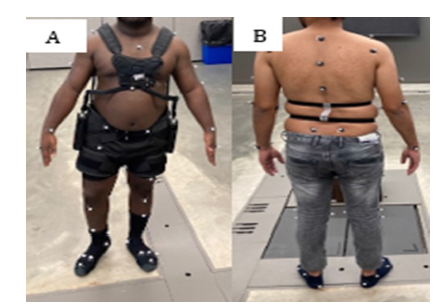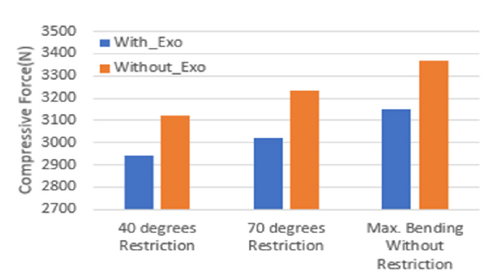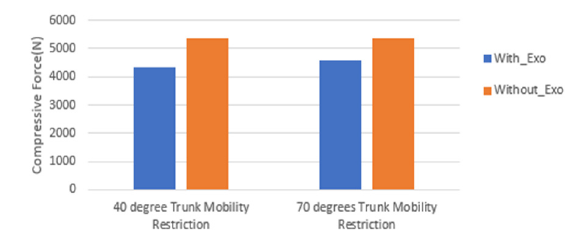- Submissions

Full Text
Examines in Physical Medicine and Rehabilitation: Open Access
Evaluating the Performance of Passive Trunk Exoskeleton in Injured Worker’s Recovery and Early Return to Work
Darlington Egeonu and Bochen Jia*
Industrial and Manufacturing Systems Engineering Department, University of Michigan Dearborn, USA
*Corresponding author:Bochen Jia, Industrial and Manufacturing Systems Engineering Department, University of Michigan Dearborn, USA
Submission: March 07, 2023; Published: March 20, 2023

ISSN 2637-7934 Volume4 Issue2
Abstract
Extended absence from work due to non-fatal injuries and musculoskeletal disorders negatively impacts a company’s productivity. Exoskeleton devices provide a means to reduce this absence from work by assisting recovering workers to timely and safely return to work. This study investigated and quantified the amount of support and L5/S1 joint load reduction provided by wearing the exoskeleton device while performing simple bending, squatting, and lifting tasks in the workplace. The preliminary results showed the potential of the exoskeleton device in spinal load reduction during tasks.
Keywords:Exoskeleton; Biomechanical; Modelling; Mobility; Rehabilitation
Introduction
Exoskeletons are robots that provide assistance for a variety of tasks and have been widely used in military and medical fields to address problems such as musculoskeletal disorders, injury from accidents, and mobility impairment [1-4]. Mobility impairment is a significant challenge in medical rehabilitation, and it can be caused by conditions such as stroke, arthritis, brain and spinal cord injuries [5]. There is a growing number of people globally who are experiencing mobility challenges as a result of workplace injuries, and one way to aid in recovery and early return to work is through physical therapy and the use of exoskeletons to provide support and assist in healing. These injuries due to accidents and the resultant mobility impairment make workers to be absent from work over an extended period, thus leading to a high loss of man-hours and a reduction in companies’ productivity. To assist in early return to work and a safe recovery process while performing their duties, workers were provided with exoskeleton devices for assistance. This study served as a pilot study sought to explore the challenge of restricted mobility faced by injured workers attempting to return to full duty. Specifically, we aimed to investigate and quantify the amount of support provided by exoskeleton devices for workers with restricted trunk mobility due to workplace accidents. To achieve this, we used passive exoskeleton devices to determine compressive loads and moments on the spine during simple tasks such as bending, squatting and lifting of simple loads. We conducted biomechanical modeling with OpenSim and Matlab software to measure the level of support provided by the exoskeleton and the results were promising [6].
Methodology
Recruitment
As a pilot study, two male adults (mean±std, age: 25±5 years, mass: 80±10kg, height: 1.78±0.03m) were recruited for this study via flyers, emails, and word of mouth. The study protocol was approved by the University Institutional Review Board..
Exoskeleton
Figure 1(A) depicts a subject wearing the HyetoneTM passive lower-extremity exoskeleton suit used in this study. The device improves productivity and reduces loads and moments on the lower back during bending and lifting activities. The device’s mass and spring mechanism stores energy when the trunk is flexed and uses it to return the trunk to a neutral standing position. The straps and paddings at the waist, thigh, and chest counteract loads on the lower back while in use.
Standardized tasks
In this study, three tasks were performed. The subject completed tasks involving bending, squatting, and lifting a 5.2kg load while wearing a mechanism that simulated restricted trunk mobility, similar to an injured worker. Figure 1(B) displays the mechanism used to constrain trunk movement, consisting of two long straps and a shorter strap with a blunt knob at the center. This mechanism limited the angle to which the trunk could bend during each task scenario to either 40 degrees or 70 degrees.
Figure 1: Subject wearing the exoskeleton device (A) and subject wearing the strap mechanism for trunk mobility restriction (B).

Data collection protocol
The study used a 12-camera Optitrack motion capture system (NaturalPoint, Inc., OR) to track the 3D coordinates of the subject’s motion during tasks, with 57 reflective markers placed on designated joint locations. The subject’s motion data were captured and processed with Motive 3.0 software choosing Biomech (57) marker sets. The ground reaction forces were measured with a Bertec force plate and filtered with a second-order Butterworth filter with a 10Hz cut-off frequency [7]. Both marker position and force data were exported to Matlab (MathWorks, MT) and OpenSim (SimTK, CA) software for biomechanical modeling.
Biomechanical modeling
A modified Beaucage-Gauvreau et al. [8] model built upon the OpenSim modeling system was used in this study. It consists of 30 segments, 29 degrees of freedom, and 238 Hill-type musculotendon actuators. The trunk consists of eight rigid body segments and six spherical joints located at intervertebral joints (T12/L1, L1/L2, L2/L3, L3/L4, L4/L5, and L5/S1). This model was used for both conditions in which subjects performed the tasks with and without wearing the exoskeleton device. In this study, the OpenSim modeling system was used to determine the compressive load at the L5/S1 joint for workers with restricted trunk mobility during bending, squatting, and lifting tasks with and without an exoskeleton device involved scaling, inverse kinematics, static optimization, and joint reaction analysis. The OpenSim model was scaled with the motion data, and inverse kinematics was used to determine the joint angles. Then, the static optimization tool estimated muscle forces, which were used together with the ground reaction forces to compute the compressive load at the L5/S1 joint with the OpenSim joint load analysis tool.
Result and Discussion
This study presented results of peak compressive loads on the L5/S1 joint for the subject during bending with trunk mobility restrictions (Figure 2) and squatting and lifting 5.2kg (Figure 3) with and without wearing the exoskeleton device. The plots indicate that compressive force increases with bending angle, with maximum values when trunk mobility is unrestricted (see Figure 2). Wearing the exoskeleton during bending, squatting, and lifting tasks resulted in lower compressive forces on the L5/S1 joints compared to not wearing the device (see Figure 2 & 3). These preliminary results are consistent with previous studies [7,9] that suggest exoskeletons can potentially reduce compressive loads on the spine during bending, squatting, lifting, and walking tasks. Also, in another study by Baltrusch et al. [10], it was determined that the use of an exoskeleton improved workers’ performance in assembly tasks that involve forward bending. Their findings agreed with our results that less compressive load is recorded at the L5/S1 joint during the bending task when a subject is wearing the exoskeleton device.
Figure 2:L5/S1 Compressive force (bending).

Figure 3: L5/S1 Compressive force (squat and 5.2kg Lifted).

Conclusion
This pilot investigation has demonstrated the potential of exoskeleton devices in L5/S1 joint load reduction and the ability to assist injured workers in returning to work timely and safely and with improvement in recovery. The ongoing part of the study will recruit more subjects to validate the preliminary results and account for gender in the model result by including female subjects.
References
- Kazerooni H, Steger R (2006) The Berkeley lower extremity exoskeleton. Transactions of the ASME, Journal of Dynamic Systems, Measurements, and Control 128(1): 14-25.
- Zoss AB, Kazerooni H, Chu A (2006) Biomechanical design of the Berkeley Lower Extremity Exoskeleton (BLEEX). IEEE/ASME Transactions on Mechatronics 11(2): 128-138.
- Steger R, Kim SH, Kazerooni H (2006) Control scheme and networked control architecture for the Berkeley Lower Extremity Exoskeleton (BLEEX). Proceedings 2006 IEEE International Conference on Robotics and Automation, pp. 3469-3476.
- Aach M, Meindl R, Hayashi T, Lange I, Geßmann J, et al. (2013) Exoskeletal neuro-rehabilitation in chronic paraplegic patients initial results. Converging Clinical and Engineering Research on Neurorehabilitation 1: 233-236.
- O'Sullivan SB, Schmitz TJ (2016) Improving functional outcomes in physical rehabilitation. 2nd (Edn.), FA Davis Company, USA.
- (2018) OpenSim Documentation.
- Koopman AS, Näf M, Baltrusch SJ, Kingma I, Rodriguez-Guerrero C, et al. (2020) Biomechanical evaluation of a new passive back support exoskeleton. Journal of Biomechanics 105: 109795.
- Beaucage GE, Robertson WS, Brandon SC, Fraser R, Freeman BJ, et al. (2019) Validation of an opensim full-body model with detailed lumbar spine for estimating lower lumbar spine loads during symmetric and asymmetric lifting tasks. Computer Methods in Biomechanics and Biomedical Engineering 22(5): 451-464.
- Kazerooni H, Tung W, Pillai M (2019) Evaluation of trunk-supporting exoskeleton. In Proceedings of the Human Factors and Ergonomics Society Annual Meeting, Sage Publishers, USA, 63(1): 1080-1083.
- Baltrusch SJ, Dieën VJH, Bennekom, CAMV, Houdijk H (2018) The effect of a passive trunk exoskeleton on functional performance in healthy individuals. Applied Ergonomics 72: 94-106.
© 2023 Bochen Jia. This is an open access article distributed under the terms of the Creative Commons Attribution License , which permits unrestricted use, distribution, and build upon your work non-commercially.
 a Creative Commons Attribution 4.0 International License. Based on a work at www.crimsonpublishers.com.
Best viewed in
a Creative Commons Attribution 4.0 International License. Based on a work at www.crimsonpublishers.com.
Best viewed in 







.jpg)






























 Editorial Board Registrations
Editorial Board Registrations Submit your Article
Submit your Article Refer a Friend
Refer a Friend Advertise With Us
Advertise With Us
.jpg)






.jpg)














.bmp)
.jpg)
.png)
.jpg)










.jpg)






.png)

.png)



.png)






